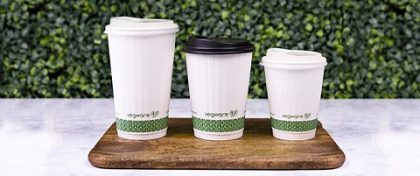 A catering manufacturing company (Vegware) has introduced PLA & CPLA with the excuse of introducing his company. No problem the text worth to read.
A catering manufacturing company (Vegware) has introduced PLA & CPLA with the excuse of introducing his company. No problem the text worth to read.
Vegware, manufactures catering disposables from a variety of plant-based materials. The company uses paper, board and pulp, but the big difference is that they don’t use conventional plastics. However, the cups still need to be leakproof, and clients still want clear windows, so the company uses compostable bioplastics that are derived from plant sources.
What is PLA?
PLA is a compostable bioplastic derived from plant sugars. PLA stands for polylactic acid. It can be made from any sugar, such as corn starch, cassava, sugar cane, or sugar beet.
NatureWorks is the world’s largest producer of PLA, and a key partner to Vegware. Industrial corn is the primary source crop at the moment, but NatureWorks are working actively to diversify feedstocks, investigating other fibrous non-food crops, or even creating lactic acid from carbon dioxide or methane
How PLA is made
Corn plants are milled to extract the starch, in the form of glucose. The glucose is then fermented to produce lactic acid. Next up, a chemical process transforms the lactic acid into a polymer, which can be made into pellets, known in the industry as resin.
Just like a conventional plastic resin, the PLA pellets can be used in a variety of ways – extruded into a sheet or film, injection moulded, cast into sheets, or spun into fibres. PLA has a huge range of applications, but Vegware uses it for:
- PLA-coated board for paper cups and soup containers
- Clear cold cups, salad containers, deli and portion pots, and lids for a variety of products
- Clear windows in sandwich wedges, salad boxes and bags
CPLA – Crystallised PLA for higher heat use
PLA has a low melt point, so is best for cold use up to around 40ºC or 105ºF. Where more heat resistance is needed such as in cutlery, or lids for coffee or soup, so the use of a crystallised form is chosen.
This involves adding chalk to the PLA to act as a catalyst, and then rapidly heating and cooling the PLA resin during production. The result is a product which is heat stable to 90ºC or 194ºF. Vegware’s CPLA products are still suitable for industrial composting, in either in-vessel or open windrow composting.
Corn for food, feed and industrial uses
The industrial corn used to make NatureWorks Ingeo PLA is non-food-grade, so it is not competing with food for human consumption. The whole plant is harvested, and every part of it is used. The protein and starch have many different uses:
- the plant-based proteins are used to make animal feed;
- the starch has many industrial uses, including in airbags, corrugated cardboard, recycled paper, pharmaceuticals, condoms, oil refining and drilling…and making PLA.
For more information about food and bioplastics read “Natureworks”
For more information about PLA read “Polyestertime”












